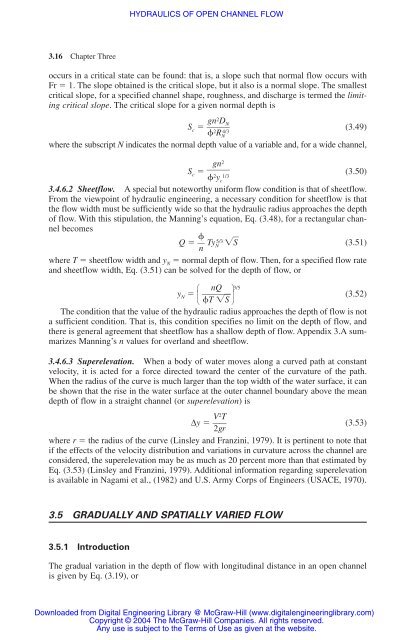chapter 3 hydraulics of open channel flow
chapter 3 hydraulics of open channel flow
chapter 3 hydraulics of open channel flow
Create successful ePaper yourself
Turn your PDF publications into a flip-book with our unique Google optimized e-Paper software.
3.16 Chapter Three<br />
occurs in a critical state can be found: that is, a slope such that normal <strong>flow</strong> occurs with<br />
Fr � 1. The slope obtained is the critical slope, but it also is a normal slope. The smallest<br />
critical slope, for a specified <strong>channel</strong> shape, roughness, and discharge is termed the limiting<br />
critical slope. The critical slope for a given normal depth is<br />
gn2D<br />
Sc � �<br />
�2RN<br />
4/<br />
N<br />
� (3.49)<br />
3<br />
where the subscript N indicates the normal depth value <strong>of</strong> a variable and, for a wide <strong>channel</strong>,<br />
gn2<br />
Sc � �� �2y<br />
1/3<br />
c<br />
(3.50)<br />
3.4.6.2 Sheet<strong>flow</strong>. A special but noteworthy uniform <strong>flow</strong> condition is that <strong>of</strong> sheet<strong>flow</strong>.<br />
From the viewpoint <strong>of</strong> hydraulic engineering, a necessary condition for sheet<strong>flow</strong> is that<br />
the <strong>flow</strong> width must be sufficiently wide so that the hydraulic radius approaches the depth<br />
<strong>of</strong> <strong>flow</strong>. With this stipulation, the Manning’s equation, Eq. (3.48), for a rectangular <strong>channel</strong><br />
becomes<br />
Q � � �<br />
n � TyN 5/3 �S� (3.51)<br />
where T � sheet<strong>flow</strong> width and yN � normal depth <strong>of</strong> <strong>flow</strong>. Then, for a specified <strong>flow</strong> rate<br />
and sheet<strong>flow</strong> width, Eq. (3.51) can be solved for the depth <strong>of</strong> <strong>flow</strong>, or<br />
nQ<br />
yN � ⎛ ⎜ �<br />
⎝ �T �S�<br />
�⎞ 3/5<br />
⎟<br />
⎠<br />
(3.52)<br />
The condition that the value <strong>of</strong> the hydraulic radius approaches the depth <strong>of</strong> <strong>flow</strong> is not<br />
a sufficient condition. That is, this condition specifies no limit on the depth <strong>of</strong> <strong>flow</strong>, and<br />
there is general agreement that sheet<strong>flow</strong> has a shallow depth <strong>of</strong> <strong>flow</strong>. Appendix 3.A summarizes<br />
Manning’s n values for overland and sheet<strong>flow</strong>.<br />
3.4.6.3 Superelevation. When a body <strong>of</strong> water moves along a curved path at constant<br />
velocity, it is acted for a force directed toward the center <strong>of</strong> the curvature <strong>of</strong> the path.<br />
When the radius <strong>of</strong> the curve is much larger than the top width <strong>of</strong> the water surface, it can<br />
be shown that the rise in the water surface at the outer <strong>channel</strong> boundary above the mean<br />
depth <strong>of</strong> <strong>flow</strong> in a straight <strong>channel</strong> (or superelevation) is<br />
∆y � � V2T<br />
� (3.53)<br />
2gr<br />
where r � the radius <strong>of</strong> the curve (Linsley and Franzini, 1979). It is pertinent to note that<br />
if the effects <strong>of</strong> the velocity distribution and variations in curvature across the <strong>channel</strong> are<br />
considered, the superelevation may be as much as 20 percent more than that estimated by<br />
Eq. (3.53) (Linsley and Franzini, 1979). Additional information regarding superelevation<br />
is available in Nagami et al., (1982) and U.S. Army Corps <strong>of</strong> Engineers (USACE, 1970).<br />
3.5 GRADUALLY AND SPATIALLY VARIED FLOW<br />
3.5.1 Introduction<br />
HYDRAULICS OF OPEN CHANNEL FLOW<br />
The gradual variation in the depth <strong>of</strong> <strong>flow</strong> with longitudinal distance in an <strong>open</strong> <strong>channel</strong><br />
is given by Eq. (3.19), or<br />
Downloaded from Digital Engineering Library @ McGraw-Hill (www.digitalengineeringlibrary.com)<br />
Copyright © 2004 The McGraw-Hill Companies. All rights reserved.<br />
Any use is subject to the Terms <strong>of</strong> Use as given at the website.

















